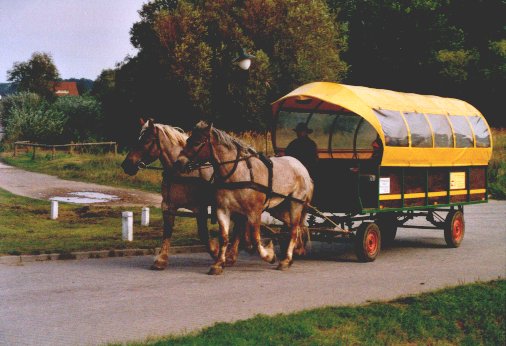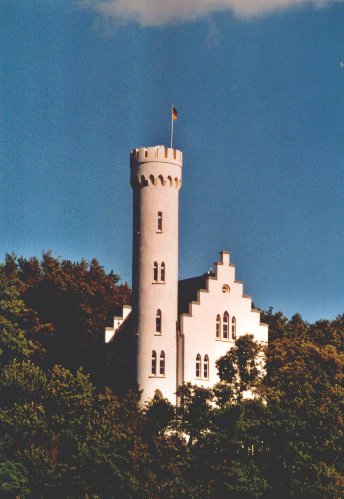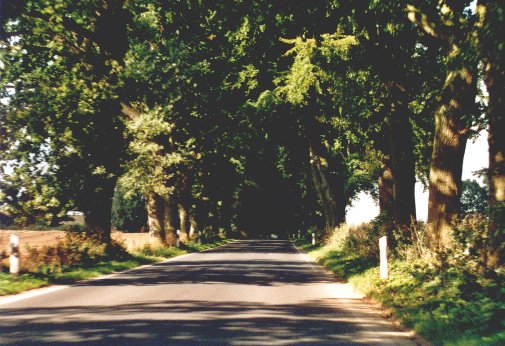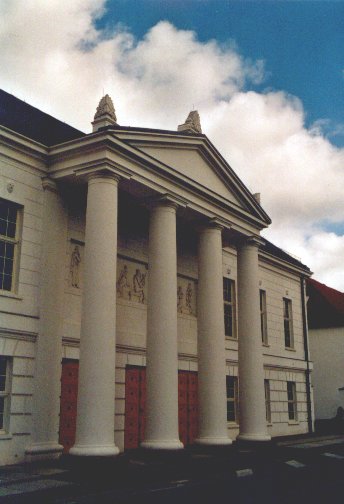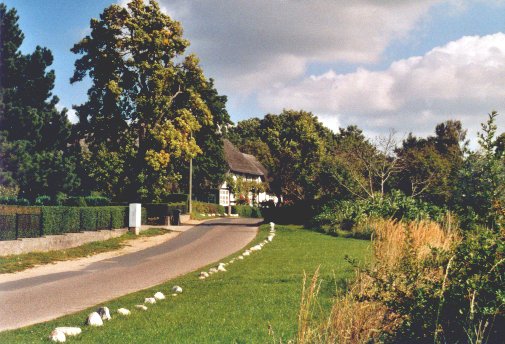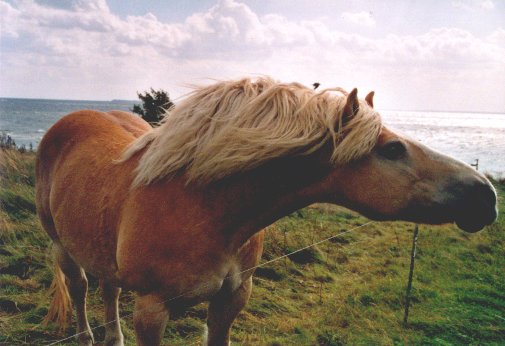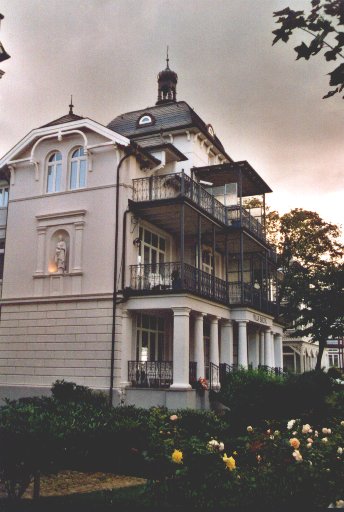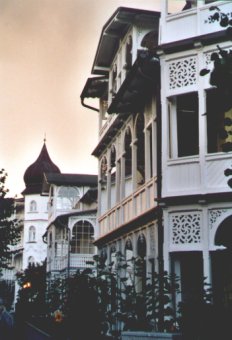 |
|
Rügen continued... |
||||||||||||||||||
|
Hiddensee 13th September was our 2nd wedding anniversary and we planned to spend the day at the island of Hiddensee. Leaving Binz at 9 a.m. we just made it for the 10 a.m. ferry from Schaprode (you can also catch a boat from Stralsund, Wiek or Breege for 14 €, here's the timetable). The crossing from Schaprode to Neuendorf is the shortest route (12.40 € each). The day ticket for the parking area was another 3 €. From there it's still a 10 minutes walk to the harbour (or you can take the tourist train). We arrived in Neuendorf, Hiddensee's southernmost village, at 10:30 a.m. and rented bikes for the day for 5 € each. During our cycle tour once across the island and back we covered approx. 17 km. Hiddensee covers 16.8 km². It spans 18.6 km in length and is no more than 3.7 km wide. Cars are not allowed on the island so the only means of transportation, if you don't want to walk, are bicycles or horse-drawn carriages. Hiking tours should start in Vitte where a circuit walk over flat land to Kloster is possible, or in Kloster. From the latter it's a 1.5 km walk to the lighthouse where many walking paths across the hilly Dornbusch area start. Or you could walk all the way from Neuendorf and hop on a return ferry from Kloster.
There are hardly any roads in Neuendorf, the houses are simply spread out over the grass. Leaving the village to the north we came through heathland and soon reached Vitte, Hiddensee's largest village, known for the Blaue Scheune, the island's last remaining rookhus (smoke house). From here it's another 2 km to Kloster, the cultural centre of the island with the former house (now a museum) and grave of the German author Gerhard Hauptmann, the Museum of Local History and the Island Church. We reached Kloster 45 minutes after leaving Neuendorf. From here we continued on the road to Hiddensee's oldest and most northern village Grieben, established in 1297. Then we had to push our bikes up a steep hill to the lighthouse, the island's landmark. Nearby is a lookout point which offers a great view of the entire island stretching out below (Inselblick). We cycled back to Vitte and had a fish sandwich (Fischbrötchen) for lunch at the harbour. Afterwards we went back to Neuendorf. It was only 2 p.m. when we got there. So we took on another 2.5 km to continue further south to the island's second and much smaller lighthouse. Back in Neuendorf we stopped at a café for coffee and cake. At 3:30 p.m. we took the ferry back to Schaprode and were back in Binz around 5 p.m. We ended our anniversary day with dinner at the "Strandhalle" restaurant (reservation required), which had been recommended to us by our hosts (45 € including wine and dessert). It was a bit out of the ordinary and very good.
Prora - Little Lichtenstein Castle - Ralswiek Castle At 10:30 a.m. we took out the bicycles from our holiday flat and cycled the 3.8 km to Prora, a huge complex of buildings constructed by the Nazis, which stretches along the Rügen coast over 4.5 km. Known as the Colossus of Rügen Prora was planned as a holiday resort (by a large state-controlled leisure organisation, Kraft durch Freude or KdF, meaning 'strength through joy') for some 20,000 people. The rooms all came with a sea view but the grey concrete-block buildings (which should have been painted white) are outstandingly ugly. At the 1937 World Exhibition the design was even awarded the Grand Prix! Unbelievable! With the outbreak of WWII the project was put to a stop. After the war the Soviets attempted to destroy two of the housing blocks but succeeded only in damaging them. During GDR times the buildings served as quarters for the East German army. Today Prora is looking towards an uncertain future. It was classified as a historical monument in 1992; after all it is one of the most imposing architectural relics of the Third Reich. But, not very surprisingly, the state has not been able to find a single investor for the whole complex. Part of it is used as a museum, a nightclub, a youth hostel. A little way off the main complex there's also a drive-in cinema, open daily during the season. We only had a look at the buildings and the beach with a view all the way to Binz, then we were on our way again. Not long after we had left Prora, the cycle path ended and we had to continue along the main road for a short distance. At Neu-Mukran we turned off into a side road towards Staphel. Then we followed some forest tracks, but it wasn't always easy to find the right direction. We met some other cyclists with the same problem. Maybe we should already have turned off at the Feuersteinfelder (flint fields), but we weren't sure if this wasn't a dead end. Eventually we did reach Lietzow and its pretty little castle, a copy of Lichtenstein castle in Southern Germany which we visited in 2002. From Lietzow we followed the cycle path next to the main road. Now we had to go uphill for a while and when we turned off towards Ralswiek the road made a steep descent. In the grounds of Ralswiek castle lies the open-air stage where the famous Störtebeker Festival is enacted every year between the end of June and the beginning of September. I would have liked to see the show, but we were one week too late into the season. Ralswiek castle is built in New Renaissance style and serves as a hotel.
When we left it was shortly after 2 p.m. Back up on the main road we followed a sign towards Kleiner Jasmunder Bodden. The path led into the forest. According to our cycle map it should have been the shortest connection, cutting through the woods, but as there were hardly any signs further on we couldn't find the right direction. After spending more than an hour trying to find a path across the rail track to the village of Stedar, we gave up very frustrated and ended up back on the main road, approx. 300 m from our starting point! It may have been easier to find the way if we had come from the other direction. We decided to continue on the official cycle track to Bergen. After a short while we took the turn-off to Prisvitz and Buschvitz, then to Zittwitz, Dumsevitz and Zirsevitz. The area continued to be hilly. At Kluptow we had to take to the main road again and at Karow we turned off towards Binz. We stopped for a coffee at the roadside and we were more than glad when were able to leave the main road and turn towards the woods again when we reached Lubkow. We couldn't get rid of the feeling that it's certainly very dangerous to cycle along Rügen's narrow avenues with their high traffic. But back in the forest, once again the path wasn't easy to find. There were no signposts at all and we didn't know which direction to take! First we tried to keep straight on, then we turned left twice. Finally we ended up back on the main road from Prora to Binz instead of coming out at Lake Schmachter as we had intended, so we had gone further to the left then we thought. But at least we now knew where we were and we could follow the cycle path back to Binz. We were back at our holiday flat at 5:30 p.m. The conclusion of this trip was that Rügen could really do with some more cycle tracks and signposts in certain places!
Putbus
- Mönchgut Once again we left at 10:30 a.m. but this time by car. We drove to Putbus, also called "the white town", built in classicist architectural style. Following plans from Prince Wilhelm Malte zu Putbus, it was founded in 1810 and became the seat of the princely family. Centre of the city is the so-called Circus, a circular square surrounded by white houses with 8 paths extending like rays to an obelisk in its middle. (Here's a link that shows a panorama view of the Circus.) Opposite are the former castle grounds, an English-style country park. The princely castle was torn down in 1962 under GDR government. Rügen's only theatre, a beautiful classicist building, is to be found in Putbus. After restoration it was reopened in 1998.
We had a look at the Circus and took a walk through the park. Then we drove to Lauterbach to have a look at the Goor bath-house. Only a few kilometres from Putbus it was built by Prince Malte as a spa and established Putbus as Rügen's first sea-bathing resort. Unfortunately the impressive "temple" with its Tuscany columns was under construction. It will open as a spa hotel in 2006. The port of Lauterbach was also a construction site, so we didn't stop there. But the road between Lauterbach and Neuendorf was very picturesque with lovely black-and-white and thatched-roof houses looking out to the sea.
Then we drove to the Mönchgut peninsula and the Thießower Haken, an area known for windsurfing, and the village of Klein Zicker which we reached at 1 p.m. We had lunch (plaice and butterfish for 27 €) at the Strandkorb Café (sitting in roofed wicker beach chairs). From here via the historic village Groß Zicker and the seaside resort Göhren we returned to Binz. We were back at our holiday flat at 3:30 p.m.
|
